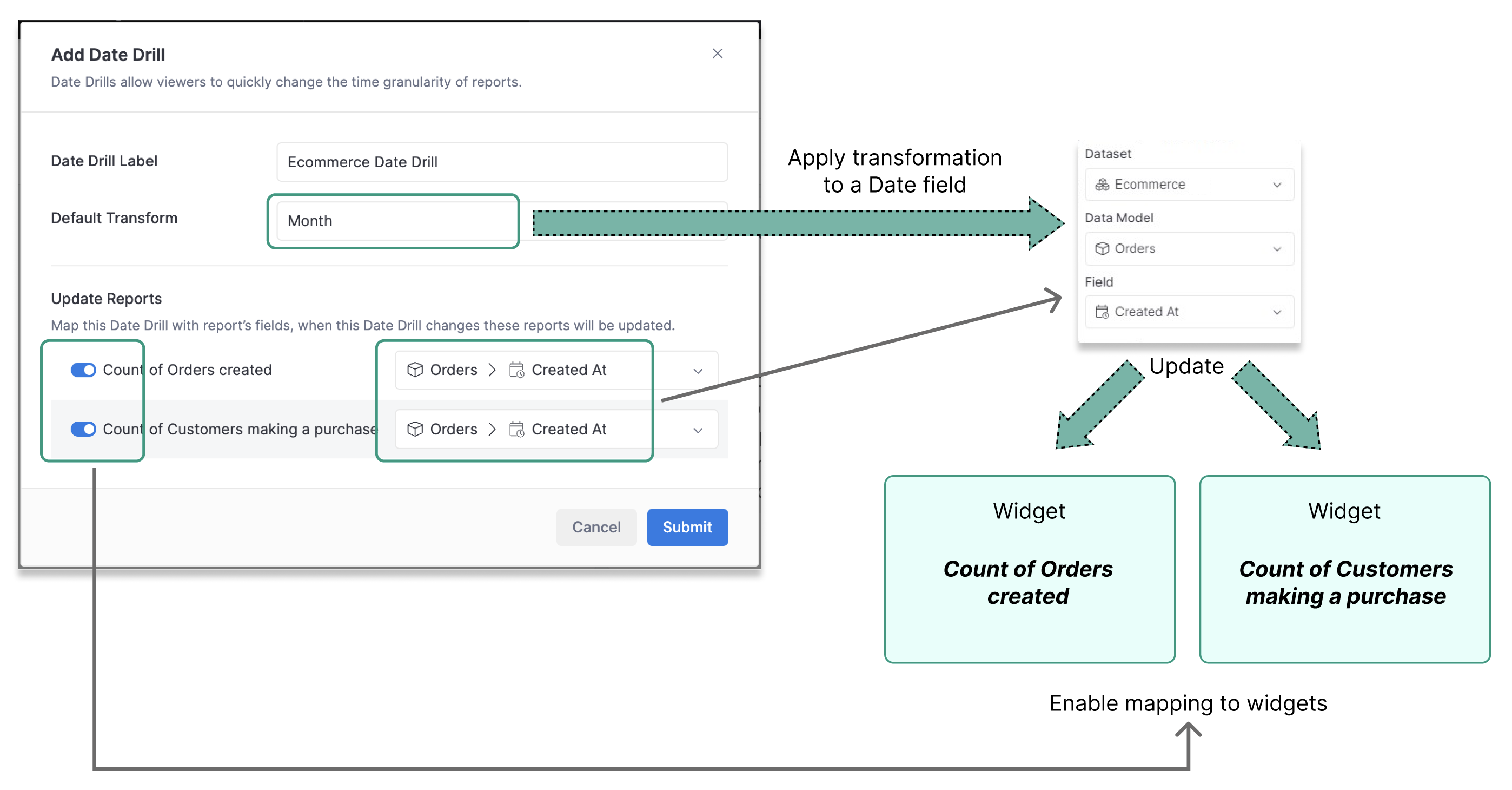Date drills
Introduction
Date Drills allow viewers to quickly change the time granularity (year, quarter, month, week, day, hour, minute) of reports. This is useful when you need to zoom out to identify a trend or zoom in to examine the details in day-to-day operations.
In Holistics, Date Drill will be available at two levels:
- Dashboard Date Drill: Requires analysts to set up
- Block / Widget Date Drill: Always available for blocks and widgets that meet the requirements
Dashboard Date Drill
When is Dashboard Date Drill useful?
As Dashboard Date Drill operates on the dashboard level, it offers certain flexibilities of a dashboard interactive feature, similar to Dashboard Filter. These include:
- Creators can selectively map several widgets to the same Date Drill at once
- The Date Drill result will persist in Export files, and it can also be set up in Schedules
How to set up Dashboard Date Drill
Follow these steps to set up a Dashboard Date Drill:
- On Dashboard: Click on the “Add Control” button, and choose “Date Drill” from the drop-down menu
- On the “Add Date Drill” modal:
- (Optional) Choose a default time granularity for transformation
- Enable the widgets you want to map to
- Choose a date field for comparison in each enabled widget
Mechanism
Date Transformation
When using Date Drill, the viewer is actually changing the date transformation of the date field in the report, without having to change it inside the Dataset Exploration view.
Mapping to a Widget(s)

Once enabled for a widget(s), Dashboard Date Drill will apply date transformation to any Date fields it is mapped to.
Widget Date Drill
When is Widget Date Drill useful
- You can quickly change the time granularity for a particular report as a temporary view.
Mechanism
Same as Dashboard Date Drill, user can change the date transformation of the date field in the report with Widget Date Drill, without having to change it inside the Dataset Exploration view.
However, Widget Date Drill only provides a temporary view of the data by different time levels. Therefore, if the viewer refreshes the dashboard, the report that they previously used Date Drill on will revert to the default date transformation or Dashboard Date Drill.
How to use Widget Date Drill
With Widget Date Drill, you change the time granularity of one single report at a time.
There are two ways to use Widget Date Drill:
- Simply right-click on the report > select Date Drill > select the time granularity.
- Hover on the report you want to Date Drill > select the Date Drill options under the report name > select the time granularity.
Considerations
Date Drill requirements
There are two requirements for Date Drill to be available:
- The report must contain a date field in the X-axis/Legend (depending on the chart type)
- (Only for Widget Date Drill) The report must be created from one of the following visualization types:
- Tabular visualization: Table, Pivot table
- Line-family chart: Line chart, Area chart, Bar chart, Column chart, Combination chart
- Pie-family chart: Pie chart, Pyramid chart, Funnel chart
Date Drill vs. Report interaction
Date Drill will override the default format of the mapped date fields in your report, unless you set the transform to "Default".
Dashboard Date Drill mapping
Each report can be mapped to only one Dashboard Date Drill at the same time.
Widget vs. Dashboard Date Drill interaction
Whichever Date Drill is submitted last will apply on the widget, regardless of whether it’s a Widget or Dashboard Date Drill.
However, do note that only Dashboard Date Drill persists resulting in export.
Permission
Users of all user roles can use Dashboard Date Drill and Report Date Drill on internal dashboards (signed in using their Holistics accounts), embedded dashboards, or dashboards shared via shareable links.
FAQs
What if I have two date dimensions in the same table?
The date drill will be applied to the first date dimension it detects, usually the one in the left-most column.
The Legacy version of Dashboard Date Drill
Previously, we had a legacy version of Dashboard Date Drill, where users had very limited control over it.
Since December 2023, a new version has been released with multiple improvements. Refer to our release note for details.